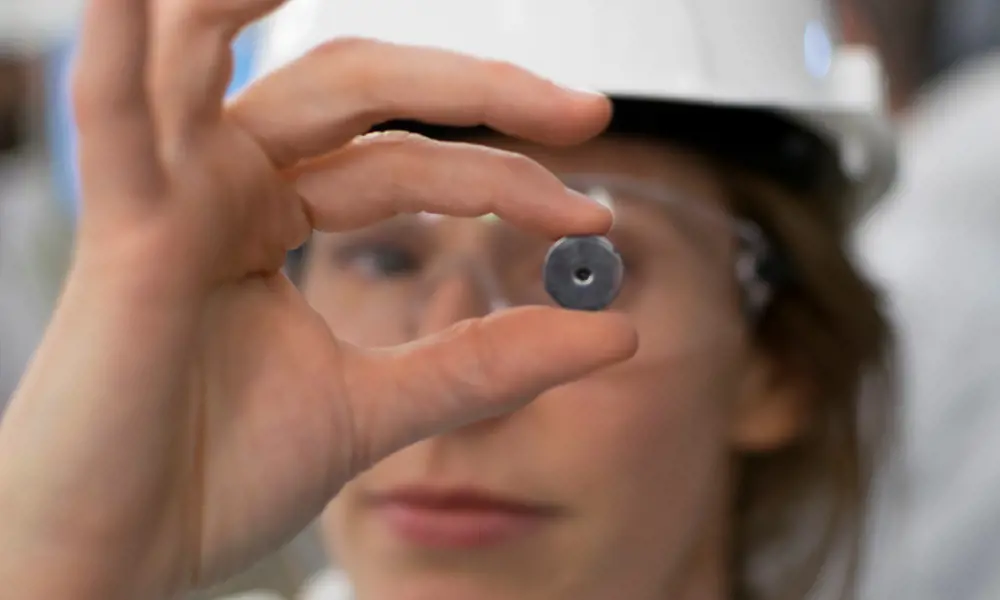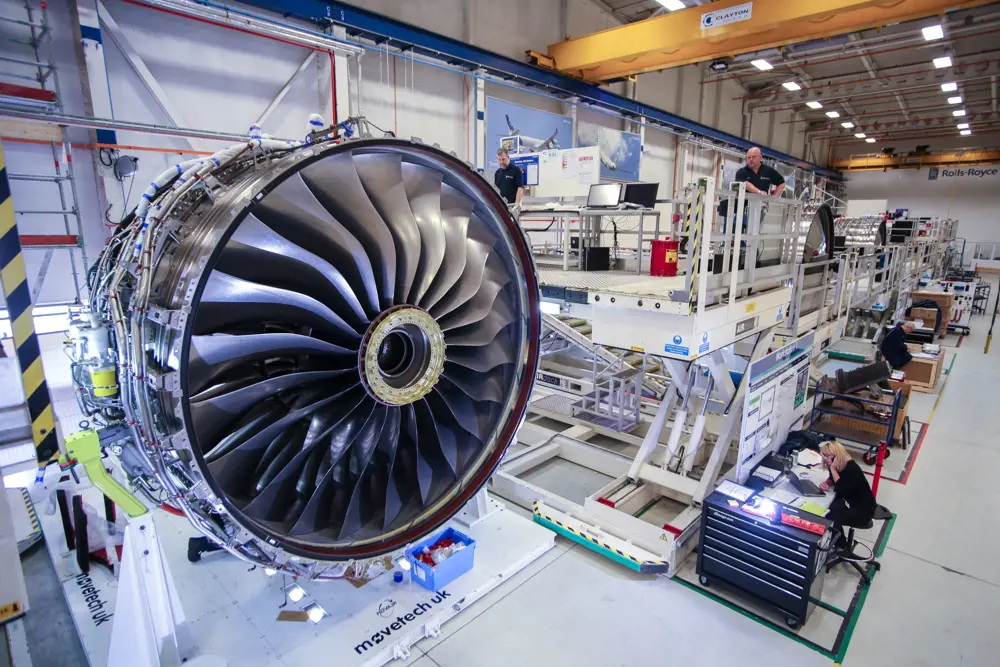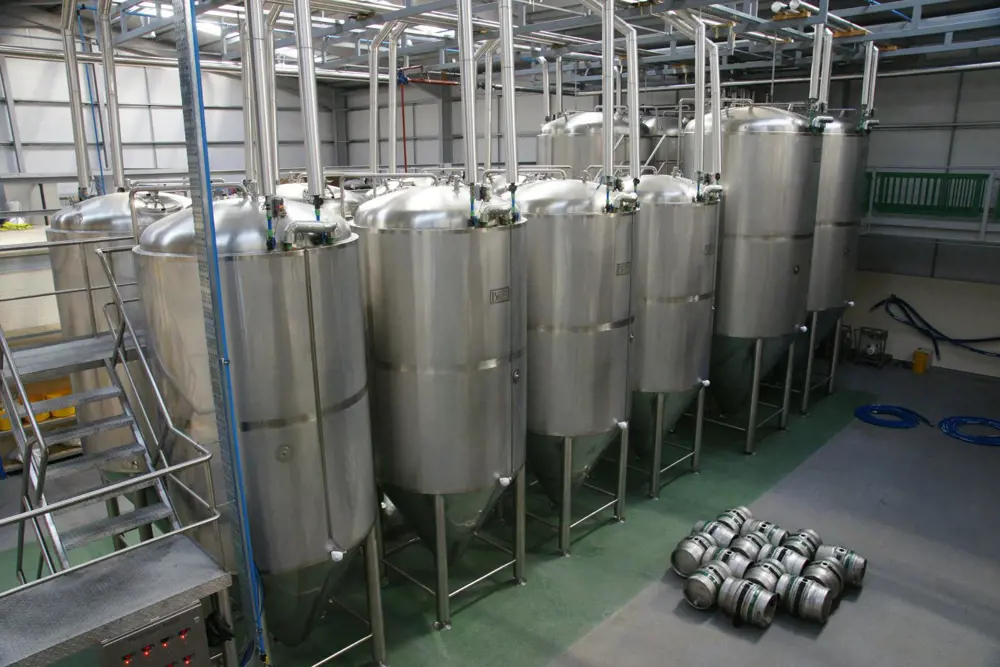
Research with impact
Research in the UK’s universities has brought significant advances in engineering. To pick just a few examples, those advances include railway ballast that reduces maintenance costs and lasts longer, better management of hospitals and their ambulances and accident and emergency departments, portable equipment for remote screening of people for hidden weapons, better design of electricity networks, and more efficient processes for brewing beer and distilling spirits. These examples are among nearly 7,000 case studies that researchers submitted to the recent Research Excellence Framework (REF) exercise as evidence of the impact of their work.
There are many ways in which research can have an impact. It can be through the creation of start-up companies, initiating product development in large and small engineering businesses, and influencing policy and efficiency drives in public bodies such as the NHS. It can even raise the profile of engineering research in the media and in the wider community. Then, of course, there is ultimate impact for many scientists: winning the Nobel Prize, which happened this year when Sir Fraser Stoddart, who has worked on over 20 projects funded by the Engineering and Physical Sciences Research Council (EPSRC) during his career, shared the chemistry prize for his work on molecular machines.
The recognition that research brings economic benefits persuaded recent governments to protect research spending, even when the state of the global economy prompted reductions in other areas of public spending. Governments naturally look for evidence that spending taxpayers’ money on research really does deliver benefits.
Governments naturally look for evidence that spending taxpayers’ money on research really does deliver benefits
How REF2014 worked
⚙️ Assessing the impact of academic research
The UK first assessed academic research in 1986, when the Research Selectivity Exercise set out to guide the allocation of a small part of research funding. The latest Research Excellence Framework (REF2014) followed a series of more comprehensive Research Assessment Exercises beginning in 1992. REF2014, the fifth in the series, was the first to request input on ‘impact’.
REF2014 worked through a series of ‘units of assessment’, effectively academic subject areas. These included engineering topics, such as aerospace and mechanical, civil and electrical, and civil and construction, along with subjects that are more likely to be a mixture of engineering and ‘core’ science where there is no guarantee of a near-term impact on engineering, such as chemistry, physics and mathematical sciences.
The Higher Education Funding Council for England (HEFCE), which ran REF, invited universities to submit evidence of their research excellence, including an ‘impact statement’, describing in their submissions the effect of the research on the wider world. HEFCE’s template for impact submission also asked for details of companies and organisations that could endorse their claims for any benefits that the research delivered.
REF proposed that the impact statement would account for 20% of the ‘marks’ that a submission could earn (output counted for 65% and environment 15%). Some academics, even if they agreed that it was good idea to assess impact, thought that it was a big jump to place so much weighting on this aspect. In the event, HEFCE opted for that level as evidence that the area was important.
For REF2014, 154 higher education institutions made 1,911 submissions, describing around 200,000 ‘research outputs’. These submissions included nearly 7,000 impact case studies. Panels of academics and ‘users’ assessed submissions, and when it came to impact, the panels’ criteria were ‘reach and significance’.
Following the conclusion of REF2014, the government commissioned Lord Nicholas Stern Kt FRS to undertake an independent review of the process. He stated that impact is important and made a useful contribution to REF, “providing a rich picture of the variety and quality of the contribution that UK research has made across our society and economy”. The review also suggested that “it is important that the total weighting for impact does not comprise less than 20% in the next exercise”. However, Lord Stern nevertheless concluded that, when it comes to assessing impact, the next iteration of the REF, due in 2020, would benefit from a broader definition of impact and from ensuring that interdisciplinary and collaborative impacts are adequately captured. The government has welcomed the Stern Review, and plans are now underway to implement its recommendations in REF.
This is where REF2014, as it is known, comes into play. It was the latest in a series of occasional exercises that set out to assess the quality of the UK’s academic research (see box). For the first time, REF2014 included reviews of the impacts of academic research to the previous assessments of ‘outputs’ and the environment that universities provide for researchers and students. Not only did the addition of ‘impact’ begin to provide concrete evidence that university research really does bring benefits to the economy and to society in general, it also sent a clear message to universities about the importance of impact, a concept that was already embedded in how Research Councils UK assessed projects that it had supported.
The terms of reference for REF2014 defined impact as “any effect on, change or benefit to the economy, society, culture, public policy or services, health, the environment or quality of life, beyond academia”. Adding impact to REF, and making it count for 20% of the ‘marks’ used to compare submissions, means that all decisions on public funding of university research now consider the impact of that activity. It also encourages universities and research groups to pay more attention to the impacts of their work, and because they had plenty of advance knowledge, to put more effort into understanding and promoting impact in the run up to the REF exercise.
The Higher Education Funding Council for England (HEFCE) and its counterparts in Northern Ireland, Scotland and Wales allocate about £2 billion per year to funding research in the UK’s universities. This is alongside the spending of Research Councils UK, including the EPSRC, the UK’s main agency for investing in research and doctoral training in engineering and physical sciences. With a total portfolio of around £4.6 billion in current projects, EPSRC invests around £800 million a year in research and skills.
Impact on engineering
As the main agency for investing in research and doctoral training in engineering and the physical sciences, EPSRC has taken great interest in REF2014 and its findings on the impact of research. It has conducted its own analysis of REF2014, focusing on more than 1,200 impact case studies directly relevant to its remit. This analysis showed that more than 1,000 of the case studies (85%) involved EPSRC-funded research and/or researchers. These impact case studies also demonstrated the variety of impacts.
For example, one obvious route for impact is in the spin-out companies that make it possible for researchers to take forward and commercialise the results of their research. EPSRC’s analysis of the REF2014 case studies found that it has supported research that led to the creation of nearly 400 new businesses, around 340 of them still active. Collectively, these spin-outs represent around 47,000 jobs and contribute around £4 billion to the UK economy. A separate study of impact submissions in computer science and informatics found that the annual revenue from spin-out companies in that sector alone was more than £170 million with nearly 1,900 employees.
Collectively, these spin-outs represent around 47,000 jobs and contribute around £4 billion to the UK economy
On the right track
🚆 XiTRACK geosynthetic reinforcement for railway tracks
XiTRACK is a geosynthetic reinforcement for railway tracks. The patented ballast technology builds on research carried out at Heriot-Watt University and the University of Edinburgh. The Edinburgh Research Partnership in Engineering (ERPE) worked on the challenges of stabilising track for conventional and high-speed rail. Heriot-Watt University then formed a spin-out company, 2Ei,to develop and market XiTRACK.
XiTRACK uses a polyurethane polymer to reinforce the ballast matrix and to reduce the need for maintenance at sites where stability and issues of track downtime are critical, such as tunnels, switches and crossings. XiTRACK allows accurate control of track forces, settlements and transient deflections. This improves the track’s engineering performance and designability.
2Ei and Hyperlast Ltd, now a part of the Dow Chemical Company, set up XiTRACK Ltd to bring the technology to market. The new business then formed a partnership with Balfour Beatty Rail to conduct trials of the new system.
Network Rail has approved the technology as a solution to ballasted track problems and XiTRACK has been applied across the UK network and overseas, including highly trafficked sites such as Clapham Junction and the MTR network in Hong Kong.
One set of points used to need maintenance every three months. The new technology, installed while trains were still running, used a pneumatic pump to apply the polymer between the sleepers. The trial was so successful that the points needed no further maintenance until they were decommissioned in 2011. In 2011, Balfour Beatty Rail adopted the design process for XiTRACK for polyurethane treated sites in the UK and overseas.
ERPE estimates that the financial impact of XiTrack is at least £50 million. Among many awards, the technology won Product Innovation of the Year at the National Rail Industry Association Awards 2015.
The research continues to break new ground. ERPE has established a Centre of Excellence in High Speed Rail in partnership with Atkins Global Plc. EPSRC-funded research of the railways group also led to the development of code to predict the critical velocity of high-speed trains and to work on different track form options for the High Speed 2 line.
In another REF case study, Swansea University describes how research in computer science and informatics is helping in the adoption in the UK of the European Train Management System, a proposed replacement for track-side signalling. For example, the Swansea Railway Verification Group at the university has advised Invensys Rail on a multimillion-pound contract that involved developing software for controlling trains at 111 stations in the UK. Invensys Rail credits the university group with helping it to develop a research-oriented ethos in the company.
Manchester Metropolitan University also submitted a REF case study describing the impact of its research on the optimisation of railway vehicle-track interaction. Along with commercial and environmental impacts, the work has led to new industry standards and best practice guidelines, as well as improvements in vehicle track interaction to minimise rail degradation.

XiTRACK is used to solve a number of track quality issues to eliminate persistent and recurring maintenance problems. The ballast technology, using strong, tough, durable polyurethane, is the result of research carried out at Heriot-Watt and Edinburgh universities © Balfour Beatty
The spin-out companies in computer science included PIXOFT Diagnostic Imaging Ltd, born out of research at Birmingham City University. Their search led to a new system for reviewing multimedia footage of crashes that helped car makers to develop safer vehicles and make better use of crash test data. Further refinement of the software resulted in Vicasso, which is now used by companies such as Jaguar Land Rover and General Motors. This example demonstrates another route by which university research can have a wider impact beyond the creation of spin-out businesses. Software tools and techniques developed in research projects can bring benefits to computing practitioners in large and small organisations. They can also lay the foundations for standards and communication protocols. Another spin-out company, from the Edinburgh Research Partnership in Engineering (ERPE), a partnership between Heriot-Watt University and the University of Edinburgh, has brought benefits in railway track maintenance. Researchers at ERPE have worked together to answer the challenges set by the need for conventional and high-speed rail travel issues surrounding stabilisation of the track that affects track maintenance. The XiTRACK ballast stabilisation technique, which uses a polyurethane polymer to reinforce the ballast matrix, is part of that research work (see box on page 38).
Important as spin-out companies can be, the economic impact of research is often more significant to the larger companies that can apply it to their own products and processes. For example, a team of electrical engineers at Imperial College London has assisted National Grid in defining new investments, affecting £3 billion-worth of network assets. It did this with important contributions to the design of power transmission networks, the equipment within these networks and non-conventional electricity systems.
Important as spin-out companies can be, the economic impact of research is often more significant to the larger companies that can apply it to their own products and processes
The work included research into converters for high-voltage direct-current technology for offshore wind generation and for medium-voltage distribution. The team extended its work into power network planning and optimisation, with a focus on electricity generation from renewable sources, such as offshore wind farms.
Imperial College London’s electrical engineering research not only benefited National Grid, but the researchers also contributed to the development of standards on supply quality and security and offshore network design standards. The impact case studies submitted to REF2014 include many examples of how engineering companies have picked up the results of academic research. For example, one company alone, Rolls-Royce, features in many submissions.
Collaboration between universities and companies is a common thread in EPSRC’s analysis of the impact case studies; it showed that nearly half of the case studies involved industrial collaboration. In all, the council’s portfolio includes more than 3,550 companies, including Rolls-Royce, BT, GSK, Siemens and Jaguar Land Rover, alongside hundreds of SMEs.

Research carried out by electrical engineers at Imperial College London to help National Grid define new investments was extended to include power network planning and optimisation © National Grid
Influencing policies
Another important and easily overlooked way in which academic research can have influence is by providing evidence for Parliament’s select committees and other public bodies. For example, the electrical engineering researchers from Imperial College London gave evidence to the House of Commons Energy and Climate Change Committee when it was preparing its report, The future of Britain’s electricity networks.
Research can influence government policy in other ways, another area where it is hard to put a value on the impact. One example of this is research at Manchester Metropolitan University where the Sensing & Imaging Group developed non-imaging radar for ‘remote’ screening of people for concealed items. The research resulted in the invention and development of new portable and rapidly deployable screening techniques. This benefited the Home Office, whose senior scientists are regular visitors to the research group, as well as the Metropolitan Police Service. This example also demonstrates the ability for research to have an impact in several ways: another beneficiary of this research was the university’s industrial partners, Anglo Scientific, which is producing devices for manufacture.
It is hard enough to put an economic value on the impact of academic research; it is even harder to assess how research helps in the operation of an organisation such as the NHS, where research affects the health and wellbeing of patients. For example, researchers at Cardiff University used mathematical modelling to identify what caused ambulance delays and queues in accident and emergency (A&E) departments at hospitals. Mathematics researchers at the university studied patient flows in A&E departments and went on to develop computer models that enabled hospital managers to simulate different scenarios and to match capacity to demand. In this way, the research helped the NHS to identify bottlenecks and where best to locate ambulances, as well as to forecast ambulance demand and plan rotas of paramedics. The findings helped to reduce patient waiting times, increasing survival rates and improving patient care. The research is helping hospitals in the UK and abroad to save lives and cut costs.
it is even harder to assess how research helps in the operation of an organisation such as the NHS, where research affects the health and wellbeing of patients
As well as delivering these less quantifiable benefits to the wellbeing of individuals, research in healthcare can also deliver direct commercial benefits. For example, research at the University of Oxford into the ability to detect patterns outside the boundaries of a model of normality, carried out in the first place in collaboration with Rolls-Royce for monitoring the health of jet engines, provided the foundation for developing new algorithms that could monitor and analyse vital signs for hospital patients. Oxford BioSignals Ltd commercialised this as the Visensia system, with £1.5 million sales to date and 137 licences sold since 2010. The US Food and Drug Administration, an important gatekeeper in the introduction of new medical technologies, approved the system’s use after a clinical trial involving 1,000 patients.
These examples illustrate the many ways in which academic research has contributed to the UK’s engineering capabilities. The EPSRC’s analysis shows that, in economic terms alone, in the 20 years from 1993 to 2013, research-enabled impacts in areas such as healthcare, energy and transport include £16.2 billion cost savings, £5.9 billion in the public sector and £10.3 billion in the private sector. This is just for research funded by the EPSRC.
Flying in good company
✈️ How Rolls-Royce is an example of the impact of academic research on the UK’s engineering sector
Aerospace company Rolls-Royce is an example of the widespread impact that academic research can have on the UK’s engineering sector. The company’s name features in dozens of the impact case studies.
In one case study, research carried out at Swansea University to gain a deeper understanding of the mechanical behaviour of proprietary engine components helped Rolls-Royce to manufacture efficient and robust gas turbine engines, contributing to a significant reduction in specific fuel consumption. The research also led to the creation of a spin-out company, Swansea Materials Research & Testing Ltd (SMaRT) with an initial annual turnover of £1 million.
At the University of Sheffield, the work of the Advanced Manufacturing Research Centre (AMRC) into machining of heat-resistant superalloys has helped Rolls-Royce to overcome some of the challenges in manufacturing aeroengine casings, some of the highest value components within the modern gas turbine with their complex geometries and exotic materials. AMRC attacked these challenges by developing a novel optimised manufacturing approach for these components.
The University of Cambridge Department of Engineering, which hosts one of Rolls-Royce’s University Technology Centres, carried out research that underpinned the design of compressors in civil aero engines and made it possible for the first time to design a 3D compressor blade as a single component.
Rolls-Royce also benefited from research into aircraft icing conducted over more than a decade at Cranfield University. The academic research helped the company to develop its own in-house analysis tools and methods. Cranfield’s experience in aerospace, in particular research into jet aerodynamics, particularly for vertical or short take-off and landing, also influenced the technology used by BAE Systems and in Lockheed Martin’s development of the Joint Strike Fighter.
Research distilled
While this may be the research council with the closest links to the UK’s engineering sector, research backed by other research councils, sometimes in collaboration with EPSRC, has also delivered benefits to the engineering sector.
bioscience research and training, supported by 20 years of investment from BBSRC, enabled £72 billion of economic activity and cost savings between 2008 and 2013

University of Oxford research on computational fluid dynamics (CFD) helped Rolls-Royce design its Trent 1000 and newer Trent XWB engines (pictured here). Researchers from the Numerical Analysis Group initially developed the HYDRA CFD package, which allowed Rolls-Royce to use CFD codes to simulate the flow of fluids in and around all products, including the flow of air through all components of diesel or gas turbine engines and their installations. Since 2009, HYDRA has become the standard aerodynamic design tool used across Rolls-Royce © Rolls-Royce
The Biotechnology and Biological Sciences Research Council (BBSRC) also analysed impact submissions to REF in its own domain. It too found numerous case studies with an engineering component in its analysis of 642 impact case studies linked to BBSRC funding. Its analysis, using different timescales and criteria than EPSRC, showed that bioscience research and training, supported by 20 years of investment from BBSRC, enabled £72 billion of economic activity and cost savings between 2008 and 2013.
One example of the impact of research funded by the BBSRC comes from work at Heriot-Watt University into brewing beer and distilling spirits. The research led to substantial improvements in the high-gravity brewing process worldwide. The university’s findings also enabled up to 50% more beer to be made in the same brewery with reduced distilling costs, potentially saving the global brewing industry more than £555 million in the capital costs associated with expanding the capacity of breweries.

Research carried out at Heriot- Watt University led to significant improvements in the high-gravity brewing process across the world © Flickr.com/johnmorris
Funding for the future
Despite these examples, it is not easy to measure the economic impacts of research. EPSRC’s analysis of the input to REF2014 shows that the impact case studies cite just over £1 billion of investment by the research council combined with £1 billion research funding from other sources, including the government, business and the EU. In all, EPSRC estimates that the £7.8 billion of research investment it has made over the period from 1993 to 2013 can be associated with approximately £80 billion of economic activity, including £16.2 billion of cost savings in the public sector and private sectors. This has been supported by the creation of 400 new businesses that have been set up to take EPSRC-supported research to market, employing around 50,000 people and contributing an estimated £4 billion to the economy.
In all, EPSRC estimates that the £7.8 billion of research investment it has made over the period from 1993 to 2013 can be associated with approximately £80 billion of economic activity
As well as confirming the contribution that the UK’s academic research makes to the economy and society in general, understanding the impact statements can also give pointers to those on the receiving end of that impact, so that companies and other agencies can benefit from establishing better connections with researchers. They can search the impact submissions – all of them open to scrutiny on the REF website – for ideas and organisations that they might want to work with. Researchers themselves can also study these impact case studies for tips on how to enhance the impact of their own work.
EPSRC itself does not leave it to chance that the research it supports will benefit the UK’s engineering community. It pioneered the use of Impact Acceleration Accounts (IAA) to help universities to plan how to communicate, translate and accelerate their research to users. Since 2012, EPSRC has invested £90 million in IAAs across 33 universities, with grants ranging from £600,000 to £6 million for a variety of activities. For example, IAAs have provided secondment grants to fund people to move across the academic/business divide, as well as proof of concept awards that take ideas nearer to market readiness.
One sign of the impact of the UK’s academic research is in the work of Innovate UK. For example, EPSRC’s analysis of the impact case studies in REF2014 showed that 90% of those that mentioned support from Innovate UK had also received EPSRC backing.
it takes time to deliver impact: the analysis reinforces the importance of long-term, sustained funding for excellent research
As EPSRC’s analysis of the impact input to REF2014 shows, it takes time to deliver impact: the analysis reinforces the importance of long-term, sustained funding for excellent research. Although benefits may be realised within a short timeframe, in general it takes much longer to realise social, economic and cultural impacts.
The analysis also highlights the importance of academia and business working together to accelerate impact. With 54% of EPSRC’s portfolio being collaborative, the idea of partnership is something that is recognised and encouraged.
Investments by EPSRC, other research councils and Innovate UK are vital in ensuring the future of the UK as a productive, connected, resilient and healthy nation – one that is always at the forefront of innovation. To achieve this, EPSRC will continue to work in partnership across all sectors to nurture scientific development and ensure that the UK is the best place to research, discover and innovate. No doubt there will be many more success stories to be told in future REF impact case studies.
***
This article has been adapted from "Research with impact", which originally appeared in the print edition of Ingenia 69 (December 2016).
Contributors
Professor Philip Nelson FREng is Professor of Acoustics at the University of Southampton. At the time of publication, he was CEO of the Engineering and Physical Sciences Research Council. He previously served as Pro-Vice-Chancellor for Research and Enterprise at the University of Southampton from 2005 to 2013. Professor Nelson holds the post of Professor of Acoustics, is a chartered engineer, and is a Fellow of the Institution of Mechanical Engineers and the Institute of Acoustics.
Keep up-to-date with Ingenia for free
SubscribeRelated content
Design & manufacturing

Super cool(er)
Welsh startup Sure Chill has developed a cooler that uses the properties of water to keep its contents cool for around 10 days without electricity. This is ideal for storing items such as vaccines where electricity sources are unreliable.

R&D investment makes good business sense
In just five years, Dr Ralf Speth FREng has presided over a revolution in design and manufacturing that has helped create a new family of engines and has overhauled Jaguar Land Rover (JLR) production facilities.

Steel can arise from the ashes of coal
Thousands of people were laid off in the UK steel industry in 2015 and there are pessimistic future forecasts. Professor Sridhar Seetharaman of the Warwick Manufacturing Group argues that smaller, flexible steel mills implementing new technology would better cope with fluctuating global trends.

Integrating metrology in business and academe
Professor Jane Jiang’s interest in measuring began when she worked on a bus production line in China. She found that the best way to improve quality, consistency and productivity was through metrology, the science of measurement. Today, she runs the UK’s largest metrology research group.
Other content from Ingenia
Quick read

- Environment & sustainability
- Opinion
A young engineer’s perspective on the good, the bad and the ugly of COP27

- Environment & sustainability
- Issue 95
How do we pay for net zero technologies?
Quick read

- Transport
- Mechanical
- How I got here
Electrifying trains and STEMAZING outreach

- Civil & structural
- Environment & sustainability
- Issue 95